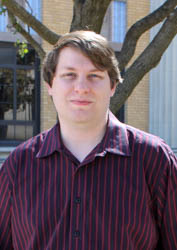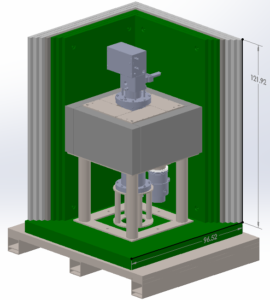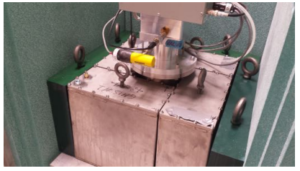Technetium-99m, a daughter of Molybdenum-99 (Mo-99), is the most popular radioisotope and is used in over 40 million medical procedures every year for diagnosing everything from heart disease to cancer. Because the US currently imports all of its Mo-99 from aging reactors overseas, the supply chain for this critical radioisotope is vulnerable to transportation problems and supply chain rupture. It also poses a concern for nuclear proliferation, since it relies on highly-enriched uranium (HEU) for its production.

In 2013, Congress passed the American Medical Isotopes Production Act to ensure a reliable U.S. supply of Mo-99 and eliminate the export of highly enriched uranium to produce medical isotopes. The US Department of Energy’s National Nuclear Security Administration responded with a program to establish a reliable supply of Mo-99 produced without HEU. These initiatives have driven research to find a viable domestic alternative method for producing these radioisotopes.
Matthew Boyd is a graduate student who is working with Center for Nuclear Security Science and Policy Initiatives (NSSPI) Deputy Director Dr. Craig Marianno. His Master’s research focused on the problem of finding new methods of producing Mo-99 without the use of HEU or low enriched uranium (LEU) targets. According to Boyd, “Mo-99 is the single most popular radiopharmaceutical and accounts for about 80% of all nuclear medicine procedures worldwide. There is currently no domestic US supplier, and the majority of the world’s supply is made in 3 reactors using LEU or HEU targets.”

Boyd worked with a private company, Global Medical Isotope Systems (GMIS), to produce a well-validated model of their neutron generator driven sub-critical assembly used for isotope production. Said Boyd, “They wanted to produce fission-based Mo-99 using depleted or natural uranium instead of low or highly-enriched uranium.”
To accomplish this, Boyd modelled the behavior of the system to predict isotope production rates and then validated that model using experimental measurements. He constructed a model of the system using the Monte Carlo N-Particle (MCNP) Transport Code and then performed dose and neutron flux measurements using activation wires to compare observed results to the simulations.

The results of the modelling pointed to a disappointing result. The MCNP model was used to estimate the source efficiency, sub-critical multiplication factor, and system power of the prototype system in its standard configuration. A subcritical multiplication factor was found to be 0.25430 ± 0.00090, corresponding to a system power of 9.78 ± 0.05 mW at standard operating parameters with errors derived solely from MCNP statistical error. This corresponds to a total 7 day Mo-99 activity production of 11.70±0.02 MBq. This is insufficient to meet any commercial demand.
“The goal of the project was to help produce a domestic supply of Mo-99 while lowering proliferation risks by removing the need for LEU or HEU targets,” Boyd explained. “However, the project showed that the company’s methodology was flawed. The current design of the system was insufficient to produce significant quantities of Mo-99.”
While Boyd’ research failed to confirm the use of the company’s initial design, it does point to future pathways for this system to be redesigned in such a way that Mo-99 production is possible.
“Neutron generators continue to advance in both reliability and yield,” remarked Boyd. “It is possible that a redesigned system based on a proper understanding of the underlying physics utilizing fissile material may provide a viable alternative.”
During his years at NSSPI, Boyd has repeatedly assisted Dr. Marianno in conducting radiological response exercises for emergency responders and international students. He also had the unique experience of participating in a disaster response training course at the Nevada National Security Site.
Like most NSSPI students, Boyd attended a safeguards workshop at Oak Ridge National Laboratory, which he noted was a “great opportunity to see both science and research done at scale and truly get a feel for how massive the Department of Energy research complex actually is.” He also represented Texas A&M at the Security, Safeguards, and Safety Symposium in Japan hosted by the Tokyo Institute of Technology, which have him a great opportunity “to travel internationally and make connections with other students and members of the field.”
Boyd completed his undergraduate education at Embry-Riddle Aeronautical University in Arizona in 2012. He double majored in Space Physics with a concentration on exotic propulsion systems and Global Security and Intelligence Studies with a concentration on Intelligence and minors in Mathematics and Technical Intelligence. He was a contributing member of Eagle Eye Intelligence, a student written OSINT publication.
Having successfully defended his thesis in October, Boyd will be graduating this December with a Master of Science degree in nuclear engineering with a nuclear nonproliferation specialization. In 2018, Boyd completed graduate certificates in Nuclear Security from the Texas A&M College of Engineering and in Advanced International Affairs from the Bush School of Government and Public Service. He will be continuing as a Ph.D. student with Dr. Marianno.